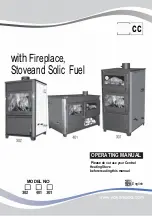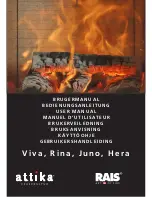
24
Encore
®
FlexBurn
®
2040 Non-Catalytic / Catalytic Wood Burning Stove
30005295
No single air control setting will fit every situation. Each
installation will differ depending on the quality of the fuel, the
amount of heat desired, and how long you wish the fire to
burn; outdoor air temperature and pressure also affect draft.
The control setting also depends on your particular instal-
lation’s “draft,” or the force that moves air from the stove
up through the chimney. Draft is affected by such things
as the length, type, and location of the chimney, local ge-
ography, nearby obstructions, and other factors. See Page
26 for details on how the installation affects performance.
Too much draft may cause excessive temperatures in the
Encore
®
, and could even damage the stove. On the other
hand, too little draft can cause backpuffing into the room
and/or the “plugging” of the chimney.
How do you know if your draft is excessively high or low?
Symptoms of too much draft include an uncontrollable
burn or a glowing-red stove part. Signs of weak draft are
smoke leaking into the room through the stove or chimney
connector joints or low heat output.
In some newer homes that are well-insulated and weath-
er-tight, poor draft may result from an insufficient air supply
in the house. In such instances, an open window near the
stove on the windward side of the house can provide the
combustion air supply needed.
Another option for getting more combustion air to the stove
is to duct air directly from outside to the stove. In some
areas provisions for outside combustion air are required
in all new construction.
The Encore
®
is equipped to deliver outside air for combus-
tion and outside air kit #3265 is available.
When first using the stove, keep track of the air control
settings. You will quickly find that a specific setting will give
you a fixed amount of heat. It may take a week or two to
determine the amount of heat and the length of burn you
should expect from various settings.
Most installations do not require a large amount of combus-
tion air, especially if adequate draft is available.
Do not for
any reason attempt to increase the firing of your heater
by altering the air control adjustment range outlined
in these directions.
Use the following air control settings as a starting point to
help determine the best settings for your installation. Each
is described as a fraction of the total distance the lever may
be moved from right to left.
Use the Air Control Settings
that Work Best for You
ST523
Intrepid
temp readings
11/00
ST523
Fig. 36
Take temperature readings with a thermometer located
in the middle of the griddle.
Surface Thermometer is a
Valuable Guide to Operation
An optional surface thermometer tells you when to adjust
the air control, and when to refuel. (Fig. 36)
For example, when the thermometer registers at least
450°F. (230°C) after start-up you know the stove is hot
enough and it may be time to close the damper. Note that
the stove will warm up much sooner than the chimney,
though; a warm chimney is the key to easy, effective stove
operation. Please review the draft management information
on Page 27 to see how the size, type, and location of your
chimney will affect your stove operation. When thermom-
eter readings drop below 350°F. (175°C) it’s time to adjust
the air control for a higher burn rate or to reload the stove.
A temperature reading over 650°F. (340°C) is a sign to
reduce the air supply to slow the burn rate.
Use the following temperature ranges as a guide:
•
Readings in the 350°-500°F. (175°-260°C) range indi-
cate low to medium heat output.
•
500°-600°F. (260°-315°C) readings indicate medium
heat output.
•
Readings of 600°-650°F. (315-340°C) indicate high heat
output. Operating your Encore
®
continuously at griddle
temperatures higher than 650° F (340°C) may damage
the cast iron or enamel finish.
Your stove is equipped with a temperature probe which
shows the operating range of the catalytic combustor.
This is located on the back of the stove and is viewed
from the top. If the probe indicator is below the operate
catalyst range, add fuel or open the bypass damper too
allow the fire to build. Closing the bypass damper should
then result in an increase in catalyst temperature to within
the operate catalyst range.
If the probe indicator is above the operate catalyst range,
the catalytic combustor is running to hot and may be dam-
aged. In many cases, increasing the primary air can re-
duce the catalyst temperature and adding less wood with
each loading can also help if overheating is persistent.
Overly dry wood can also cause overheating of the cata-
lyst element. Do not add wood to the stove if the probe
reads above the operate catalyst range.
Temperature Probe
















































